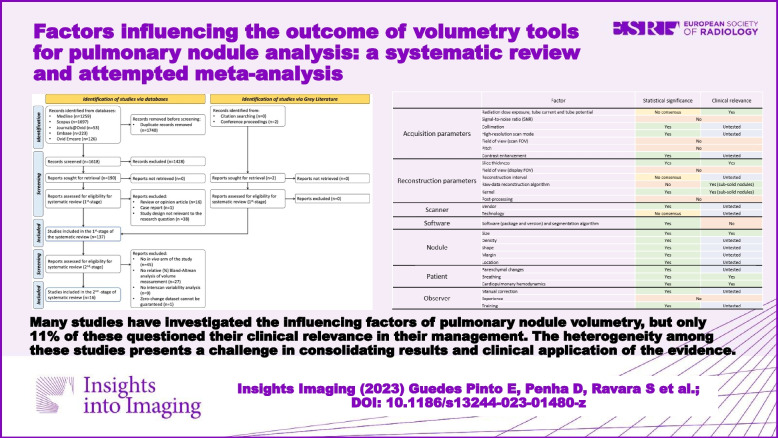- Record: found
- Abstract: found
- Article: found
Factors influencing the outcome of volumetry tools for pulmonary nodule analysis: a systematic review and attempted meta-analysis

Read this article at
Abstract
Abstract
Health systems worldwide are implementing lung cancer screening programmes to identify early-stage lung cancer and maximise patient survival. Volumetry is recommended for follow-up of pulmonary nodules and outperforms other measurement methods. However, volumetry is known to be influenced by multiple factors. The objectives of this systematic review (PROSPERO CRD42022370233) are to summarise the current knowledge regarding factors that influence volumetry tools used in the analysis of pulmonary nodules, assess for significant clinical impact, identify gaps in current knowledge and suggest future research. Five databases (Medline, Scopus, Journals@Ovid, Embase and Emcare) were searched on the 21st of September, 2022, and 137 original research studies were included, explicitly testing the potential impact of influencing factors on the outcome of volumetry tools. The summary of these studies is tabulated, and a narrative review is provided. A subset of studies (n = 16) reporting clinical significance were selected, and their results were combined, if appropriate, using meta-analysis. Factors with clinical significance include the segmentation algorithm, quality of the segmentation, slice thickness, the level of inspiration for solid nodules, and the reconstruction algorithm and kernel in subsolid nodules. Although there is a large body of evidence in this field, it is unclear how to apply the results from these studies in clinical practice as most studies do not test for clinical relevance. The meta-analysis did not improve our understanding due to the small number and heterogeneity of studies testing for clinical significance.
Critical relevance statement
Many studies have investigated the influencing factors of pulmonary nodule volumetry, but only 11% of these questioned their clinical relevance in their management. The heterogeneity among these studies presents a challenge in consolidating results and clinical application of the evidence.
Key points
• Factors influencing the volumetry of pulmonary nodules have been extensively investigated.
• Just 11% of studies test clinical significance (wrongly diagnosing growth).
• Nodule size interacts with most other influencing factors (especially for smaller nodules).
• Heterogeneity among studies makes comparison and consolidation of results challenging.
• Future research should focus on clinical applicability, screening, and updated technology.
Related collections
Most cited references181
- Record: found
- Abstract: found
- Article: not found
Guidelines for Management of Incidental Pulmonary Nodules Detected on CT Images: From the Fleischner Society 2017.

- Record: found
- Abstract: found
- Article: found
Central focused convolutional neural networks: Developing a data-driven model for lung nodule segmentation
- Record: found
- Abstract: found
- Article: not found
